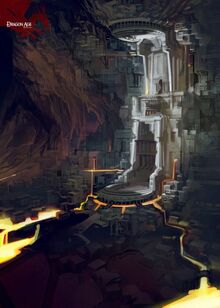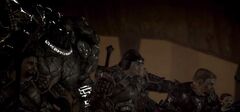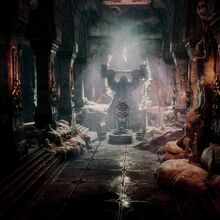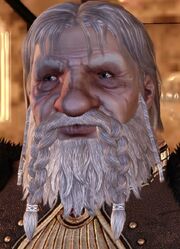“Time, in the end, is one long Proving, and we are failing at the test.” ―Warrior Etrol of House Saelac[1]
The history of the dwarves is by far the most detailed and well-recorded history in Thedas thanks to the Shaperate of Memories institution.
History[]
Early Years[]
The titans used to roam the land and reshape the earth. The titans sang to each other the eternal hymn, the prayer, and the proclamation of "Isatunoll". Isatunoll is described as an affirmation; a statement of existence and of being. Isatunoll roughly translates to "I/we are here." It is the eternal hymn that encompasses all time and spaces.
The titans' progeny, the dwarves, were part of Isatunoll.[2] Isatunoll is suspected to be a sort of hive mind with a system of understanding one's purpose, and also understanding instinctually how that purpose fits within the whole.[3]
When the Evanuris were still primeval spirits who wanted to become corporeal, they used raw lyrium to craft physical bodies for themselves, thus becoming the first Elves. In the process, however, they angered the Titans, as the lyrium they were using was the Titans’ blood, and entered into a war with them. When the elves were losing the war, Mythal had Solas craft a Lyrium Dagger which Fen'Harel used to sever the Titans' connection to the Fade, rendering them Tranquil. The Titans' dreams, now severed from their hosts and locked away inside the Fade, mutated into the Taint and Blight out of anger, fear, and confusion. Solas banished these corrupted dreams which would become the Blight to a prison which would be known to contemporaries as the Black City.
The Evanuris weaponized the Blight in their wars of supremacy, especially during Solas' rebellion against them. For unleashing the Blight onto the world, Solas imprisoned the Evanuris in the Fade and used their lives to sustain the Veil. Yet Solas did not anticipate that the Elven pantheon that he had imprisoned would speak through the Old Gods and manipulate the Magisters Sidereal into breaching the Black City and releasing a portion of the Blight onto Thedas.[4][5]
After the elves' war against the titans, some titans became dead while others became dormant and forgotten. The dwarves were changed after the titans fell—they forgot Isatunoll and became individualistic, discordant, and insensitive to the titans. The dwarves formed their own kingdoms and sold lyrium—first to the Tevinter Imperium—for gold.[2]
Tens of thousands of years of dwarven history are stored in the Memories.[6] Some Shapers claim that they date back to the founding of the first thaig.[7]
The Shaperate speaks of a Thedas entirely devoid of humans, a time when elves reigned over the land and dwarves ruled the underground.[8] In -4600 Ancient (-3405 TE) the elves of the great elven kingdom of Elvhenan are said to first make contact with the dwarves, 1,500 years before the arrival of humans.[9] However much has transpired that has not been recorded in the Shaperate's Memories.
According to Shaper Valta, the Titans fell and the dwarven race with them, breaking in two.[10] Solas compares dwarves to a "severed arm of a once mighty hero, lying in a pool of blood".[11] Ancient elven text speaks about the ancient elves hunting "the pillars of the earth" to force growth from their corpses, claiming the dwarves were “witless and soulless” and that “this death will be a mercy”.[12], however this is a reflection of the ancient elves’ beliefs, and not necessarily an accurate statement.
Veilfire runes in an ancient mine depict figures of Mythal leading a charge against the titans and killing at least some of them. Lyrium was then mined from their bodies. An aeon later the mine was sealed away.[13] The Dalish tell a story about how the dwarves fear the sun because of Elgar'nan's fire which they believe is a metaphor for the ancient elves driving the dwarves underground.[14]
Two thaigs used the runework of the most talented Shaper of Runes in dwarven history, Paragon Fairel, to build fantastic weapons of destruction. In order to escape or to avoid a war, he took his own house and several others, and departed from his brethren. Under the sandy desert of the Hissing Wastes, he established the only known above-ground thaig: Kal Repartha, which means in dwarven language "a place where we may meet in peace".[15][16][17]
The Forgotten War was fought between the dwarves and the Scaled Ones sometime after the founding of the Tevinter Imperium in -1195 Ancient, but before the destruction of Cad'halash Thaig around -975 Ancient.[20][21]
Golden Age[]

The great thaig of Orzammar
For thousands of years until the beginning of the First Blight, the dwarven empire expanded and prospered. Orseck Garal and Endrin Stonehammer are two of those great rulers during this golden age with the latter forging an alliance with the first Tevinter Archon, Darinius, in -1200 Ancient (-5 TE).[22] The alliance of the dwarves with the Tevinter Imperium still lasts up to present day.
Eventually in -1170 Ancient (25 TE)[23], Stonehammer moved the capital of the empire to Orzammar to preside more directly over the commercial aspects of dwarven life, mining and crafting, as Orzammar was the ancestral seat of the Mining and Smith castes[24] and because of the turmoil in the Imperium following the death of Archon Darinius.[25] He also expanded and improved the city, creating the legendary Stonehammer Hall and enlarging the Orzammar Proving to allow for massive tournaments.[26] In this period of great flourishing and wealth, thaigs were built under every human kingdom, and the Deep Roads experienced great development as the dwarves' chief method of travel between their cities.
The empire was encompassed by several kingdoms, some of them being Kal-Sharok, Orzammar, Gundaar and Hormak. At least since the times of the First Blight, each kingdom had its own Assembly, which maintained allegiance to the capital of the empire.[27]
After the destruction of Arlathan in -975 Ancient,[21] several elves sought shelter in the Cad'halash Thaig. However, once the dwarves of Kal-Sharok discovered this development, they destroyed the thaig in order to conceal all the evidence and avoid jeopardizing the alliance with the Tevinter Imperium.[28]
First Blight[]

The fall of the dwarven empire
The darkspawn first appeared underground in 800 TE. At first travelers on the Deep Roads disappeared while the darkspawn concentrated on multiplying their numbers.[29][30] When the Warrior caste sent soldiers to patrol the Deep Roads, they started to go missing while on duty—the attacks they suffered were subtle at best, nothing to truly indicate what was to come.
The First Blight is arguably the single most devastating event in the history of the race. The empire came to its knees as darkspawn flooded the Deep Roads that connected the countless thaigs and cities. Political disunity among the warrior and noble castes and the inability to focus on effectively stopping the darkspawn resulted in the loss of countless thaigs, pushing the dwarven race to the brink of extinction. In these perilous times, Paragon Aeducan arose sometime after 815 TE[29], and with his resourcefulness he saved the empire as well as achieved the first victories against the darkspawn horde.[31]

Dragon Age Journeys' depiction of the fall
More than a century later and with the First Blight still raging, in -255 Ancient one of the dwarves' greatest engineering feats was developed: the creation of the Anvil of the Void, created by Paragon Caridin, which could forge giant golems. These controllable creatures, bipedal warriors of stone or metal, were devastating on the battlefield and allowed the dwarves to push the darkspawn back and reclaim some of their lost territory. The master smith constantly produced golems for six years until King Valtor started using the Anvil to turn casteless, criminals, and political enemies into golems, instead of just volunteers.[32] Caridin objected and in turn was made into a golem himself. However, his apprentices knew not how to properly construct a control rod, allowing Caridin to retain his free will and mind. Caridin disappeared into the Deep Roads in -248 Ancient[33], taking his followers and the Anvil with him.[34]
This single event extinguished from the dwarves any hope for a final victory against the darkspawn. Caridin was presumed dead and no other dwarf had been able to replicate his breakthrough ever since. Out of desperation, in the second year of the reign of Queen Getha, the dwarves sent the entire Legion of Steel (i.e., the last remaining all-golem regiment) into the Deep Roads with orders to recover Paragon Caridin. However, no golems did ever return. Due to the incalculable loss of the Legion of Steel, Queen Getha was deposed, and the Shaperate declared Caridin dead and never again allowed an all-golem unit into the deep roads, allowing their use only in the direst of emergencies.[35] The use of golems on a military scale declined over time until it became but a memory. Only the cooperation of the four major kingdoms allowed them to survive.
Eventually the First Blight was defeated with the death of Archdemon Dumat in the Battle of Silent Plains in which the dwarven army also participated.[36]
Decline[]

Ancient treasures left behind
With the retreat of the darkspawn underground, victory was declared on the surface but the war for the dwarves was far from over. Even without an Archdemon's guidance, the darkspawn continued their relentless push against the severely weakened dwarven empire. In response, most of the Deep Roads were sealed, causing communication lines to falter between the surviving kingdoms. As a result, in -195 Ancient (1000 TE), each kingdom elected its own king while maintaining allegiance to the High King of Orzammar.[27]
However, the darkspawn continued pushing. In an effort to save the dwarven race from complete annihilation, High King Threestone ordered the sealing of the Deep Roads, leading to the remaining three kingdoms in -40 Ancient (1155 TE).[37] Paragon Egon Wintersbreath led the defenses of the kingdom of Hormak but that was not enough, and within a decade the kingdoms of both Gundaar and Hormak had fallen.[38][39] The last of the Deep Roads are sealed in -15 Ancient (1180 TE), cutting off Kal-Sharok which was believed lost.[40] The kingdom of Orzammar had become the only bastion of dwarven culture in Thedas, the last prosperous thaig of the dwarven race.
Ages[]
Even though the sealing of the Deep Roads significantly decreased the pressure on Orzammar, the darkspawn were able to find ways to breach them. For the next centuries, the kingdom was in a steady decline by losing most of its outlying thaigs. Despite that, the strict traditions of Orzammar's culture as well as its alliance with Tevinter Imperium persisted.
During the Fourth Blight, the dwarves of Orzammar assisted the Imperium in lifting the siege of Marnas Pell[41]; however, the Ortan Thaig was lost.[42]
In 8:96 Blessed, Endrin Aeducan became the new king of Orzammar.[43] Two years later, the prominent noble House Tethras was exiled to the surface for denying the Voice of the Ancestors and willfully manipulating the sacred Provings.[44][45]
Present day[]

King Endrin Aeducan died at the beginning of the Fifth Blight
In 9:12 Dragon, it is discovered that the kingdom of Kal-Sharok had in fact survived. However, the relations between the two kingdoms are strained because Orzammar demands Kal-Sharok's allegiance and because it was abandoned by Orzammar a millennium ago. One year later, after exchanging hands numerous times, Bownammar is permanently lost to the darkspawn—the last great loss of the dwarves.[46][47]
In 9:30 Dragon, King Endrin passes away, starting a political crisis between the two competitors for the throne. The Warden eventually helps one candidate get elected as the new king of Orzammar. The dwarves honor their treaties with the Grey Wardens by sending an army to assist Ferelden in defeating the Fifth Blight. Around this time, the Primeval Thaig is rediscovered beneath the Free Marches.
In 9:32, a dwarven army led by House Helmi to the great thaig of Kal'Hirol clears the Deep Roads connecting it to Orzammar of darkspawn, reclaiming it once again.
Despite the outbreak of the Mage-Templar War and the War of the Lions in 9:40 Dragon and the War against the Elder One in the following year, Orzammar is not directly impacted by the devastating warfare and escapes unscathed. However, due to reliance on food imports from the surface, the city experiences significant food shortages which leads to riots.[48]
Between 9:41 and 9:42 Dragon, the Inquisition may gain Orzammar's friendship and as a result the reigning king will send legionnaires, lyrium, and financial aid. Around this time, the dwarves of Kal-Sharok will leave a cryptic message to the Inquisition which may lead to cooperation against the Venatori.
On the same year, the king of Orzammar sends the Legion of the Dead to assist the Shaperate in investigating the repeated earthquakes which disrupted the lyrium mining operations and broke the tunnel seals, allowing the darkspawn to pour in. These mines are vital for the surface's supply of lyrium as well as Orzammar's economy. Thus the dwarves appeal to the Grey Wardens for aid but after they receive no response, they contact the Inquisition. This can lead to the discovery of the Sha-Brytol dwarves and scarce information on the Titans.
Dragon Age RPG[]
During the Golden Age of the dwarves, artisans and engineers pioneered new crafting methods and built many cherished monuments to dwarven history, such as Gundaar's House of Crystalline Waters, a massive underground lake decorated with shining quartz stalactites reflecting colors no dwarf had ever seen.[49]
In the Divine Age and for a 30-year period, Orzammar was ruled by The “Lost King” who was utterly removed from the Memories, and thus his deeds are unknown.[50]
In the Towers Age, the Chasind Wilders along with other "terrible things" were led by Flemeth's daughters, the Witches of the Wild. This force invaded the region of what would be Ferelden and were all but unopposed until the hero Cormac led an army of Alamarri fighters and Orzammar dwarves. After a long series of dreadful battles, the Chasind were all but destroyed, and the witches burned.[51]
References[]
| ||||||||||||||||||||||||

